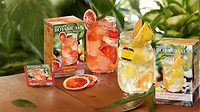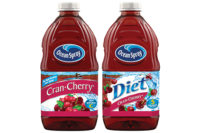Health benefits of berries continue to resonate with consumers

Blueberries meld well with a variety of flavors in multiple applications, from healthy juices to beauty-from-within drinks to nouveau non-alcohol cocktails, according to the U.S. Highbush Blueberry Council.

Traditional berry flavors dominate the beverage category; however, more exotic offerings such as acai, goji berry and acerola are sparking consumer interest, Tree Top says.


What if humans could extend their lives just by consuming a particular type of berry? According to the National Institute on Aging (NIA), that might be possible. Using a model to study life extension, the NIA reported a life extension effect when acai was added to the diet, as reported in Experimental Gerontology. Since that publication, a team of investigators from three universities and the NIA have confirmed the observed life extension effect in a second species, says Alexander Schauss, Ph.D., senior research director of natural and medicinal products research for AIBR Life Sciences Inc., Puyallup, Wash.
Other studies have shown that acai can protect human cells from oxidative stress that would damage cells.
“Research on acai began in earnest in 1995 when scientists working at AIBMR Life Sciences saw a report that a palm tree in the Amazon could overcome the damaging effect of oxidative stress from lack of oxygen during seasonal flooding and exposure to UV radiation near the equator,” Schauss says. “Noticing that the palm tree also produced a fruit, the mature fruit was freeze-dried and studied in numerous laboratories in the USA.”
After multiple studies were conducted, research has shown that acai has the highest antioxidant capacity against all of the major free radicals in other berries; the most potent anti-inflammatory flavonoid found in food can be found in acai pulp; and compounds exist in acai that reduce the overproduction of inflammatory compounds commonly found in degenerative diseases, Schauss says.
“Elite athletes, in particular, go into states of oxidative stress simply from how much oxygen they breathe, which increases free radical production due to exhaustive exercise and physical exertion,” he explains. “Given the presence of potent anti-inflammatory compounds in acai’s pulp, it is surprising that acai is not found in most, if not all, sports drinks.”
The berry also can be associated with benefits in weight management, aging, digestive health, diabetes, metabolic syndrome, immune function, cardiovascular health, cognition and brain function, Schauss says.
“Acai’s strength in the marketplace over the last decade is a testament to its staying power and place among innovative functional beverages,” he says.
With the power to extend human lives, reduce inflammation and protect cells from oxidative stress, it’s no wonder acai is called a superfruit. However, other berries offer “super” benefits as well. In fact, blueberries often are referred to as the original superfruit, according to Tom Payne, industry consultant for the U.S. Highbush Blueberry Council, Folsom, Calif.
Recently, blueberries have increased in popularity due to their nutritional properties.
“Blueberries are known as an antioxidant superfruit, packed with anthocyanins and phytonutrients that deliver the nutritional health benefit to your body,” says Karl Baer, director of sales and marketing for Wyman’s of Maine, a founding member of the Wild Blueberry Association of North America based in Milbridge, Maine.
Studies suggest that wild blueberries’ antioxidant and anti-inflammatory properties can help protect against diseases such as cancer, heart disease, diabetes and Alzheimer’s, according to the Wild Blueberry Association of North America.
They also have become more popular due to their versatility, the U.S. Highbush Blueberry Council’s Payne says.
“Part of the reason [for the increase in popularity] is health, but part is also the amazing, across-the-board appeal of blueberries with consumers as well as product developers who appreciate the many types of blueberry products available for use in beverages,” he says. “With regard to beverage formulation, blueberries have always been popular because of their amazing versatility: fresh, frozen, IQF (individually quick frozen), purees and plump osmotically preserved blueberries, which add color, texture and lush taste.”
In smoothie and dairy drinks, blueberries can add effects such as blue swirls and patterns. The berry’s color and texture also complement these drinks, Payne says. Frozen IQF blueberries are especially suited for smoothies and other beverages, he adds.
Furthermore, blueberries can be used to enhance the sweetness of a beverage, Payne says.
“Blueberries with their natural high sugar levels help to remove the sour taste sometimes associated with yogurt and naturally sweeten the product,” he explains. “The fresh appeal is also attractive to health-conscious consumers. Now, drinkable yogurts are utilizing blueberries and blueberry puree to impart a natural taste and blue appeal.”
For tea drinks, blueberry powder is available, made from fresh or frozen blueberries or puree that is drum-dried and ground into powder or flakes to specifications. Other ingredient formats that work particularly well in beverage applications include single-strength juice, which is made from fresh berries that are crushed, pressed, filtered, pasteurized, packaged and frozen; and blueberry juice concentrate that is made from fresh blueberries that are crushed, heat/enzyme-treated, vacuum-concentrated, packaged and frozen, Payne says.
“Beverage formulators know they can put blueberries on the label and take advantage of the image of blueberries as a healthy, delicious fruit full of natural goodness [that enhances] the positive associations of comfort food,” he says.
To showcase real highbush blueberries in food and beverage products, the U.S. Highbush Blueberry Council developed The Real Blueberry Seal. To feature this seal, products must contain real highbush blueberries in any form and use an adequate amount of blueberries so that they can be seen or tasted, Payne explains.
In beverage formulations, blueberries can be combined with many other flavors synergistically.
Blueberries pair well with other high-antioxidant fruits, such as pomegranates, tart cherries and acai, Wyman’s Baer says. They also meld well with flavors such as ginger, cocoa, chocolate, caramel and lemonade in a wide variety of applications, from healthy juices to beauty-from-within drinks to nouveau non-alcohol cocktails, Payne says. Lately, there has been an increase in formulating blueberry ingredients into fiber drinks, he adds.
Another berry that blends well with other flavors is cranberry.
“It works very well with other flavors because of the acidic nature of it,” explains Deborah Hartig, product and process development for Decas Cranberry Products Inc., Carver, Mass. “It enhances other flavors like any acid does. When you blend cranberry with something else, you can still taste the cranberry, but you also get that secondary flavor whether it’s a granny smith [apple] or a pineapple or a mango; that second flavor comes out very nicely.”
One of three native fruits to America, cranberries have become well-known for their health attributes. According to Hartig, it was one of the first products to highlight health claims.
“If there’s one particular product that’s top of mind with consumers for [urinary tract infections] (UTIs), it’s cranberry,” she says. “The case for UTIs has been pretty well documented with the use of cranberry juice and its anti-adhesion property.”
For beverage applications, Decas Cranberry Products offers cranberries in multiple formats. The company’s PACran powders are made from whole ground cranberries that are custom-designed to provide a set amount of antioxidant potential by utilizing the active compound in the cranberry cuticle. Its Hi-PAC extract powders are custom-made from cranberry juice, which is then concentrated and spray dried. These powders are soluble, but not completely soluble, so they are ideal for nutritional supplement-type products, Hartig says.
NutriCran is a line of highly soluble cranberry juice concentrate powders that can be used in all types of beverages, she says. The company also offers liquid cranberry juice concentrate and organic cranberry juice concentrate, she adds.
“If you had a clear beverage, you would want to use a soluble cranberry powder,” Hartig explains. “But if you had something with soy protein, you would be able to use a PACran. So you would want to review your formulation, because with protein drinks, among that particular consumer group, sludge or sediment at the bottom is not considered a negative.”
Tree Top Inc., Selah, Wash., offers a wide variety of berry ingredients for beverages in the form of juice concentrates, single-strength and concentrated fruit purees, and formulated fruit preps, says Jason Whitman, business development for Tree Top.
“Concentrates are an excellent addition for fruit-based drinks, fruit-flavored teas as well as fruit-flavored spirits, wines and beers,” he says. “Fruit purees and preps are great for nectar-style drinks, drinkable yogurts and smoothies.
“Fruit juice concentrates, essences and With Other Natural Flavors [ingredients] provide an economical way to add fruit flavor and color to a variety of beverages,” he continues. “Fruit purees can offer a thicker, more textural mouthfeel as well as visual piece identity, which makes them ideal for nectar-style drinks and smoothies.”
When formulating a beverage with Tree Top berry ingredients, beverage-makers have the ability to label their products “made with real fruit,” which relays the good-for-you health benefits of the ingredients, Whitman says.
Fruit juices, nectars, fruit-flavored still drinks and teas are the top beverage categories that make use of berries as ingredients, he says. According to Chicago-based market research firm Mintel’s Global New Products Database, blueberry, cranberry, strawberry, mixed berry and raspberry were the top berry flavors introduced globally in beverages in the last year. These traditional berry flavors dominate the beverage category; however, more exotic offerings such as acai, goji berry and acerola are sparking consumer interest, Whitman says.
“Consumer palettes are being influenced by global flavor trends and the desire of consumers to be transported to a different place,” Whitman says. “Although traditional berries will probably remain at the center of berry-flavored beverages, more playful and adventurous flavors, such as some of the exotic berries, may become more accepted and mainstream.” BI
Looking for a reprint of this article?
From high-res PDFs to custom plaques, order your copy today!










